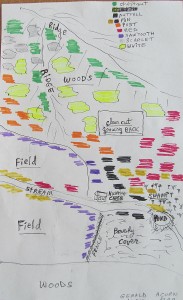Most hunters think tactically in two broad categories: 1) hunting “open country” such as fields or food plots and 2) “hunting the woods.” And hunting the woods usually means hunting near oak trees that are dropping acorns.
Well, that’s certainly a good starting point. But things get a little more complicated after that, especially when hunting the second habitat category — the woods.
There are many, many species of oaks. In fact, well over 400 have been identified. Some thrive in one habitat and not another. Some drop their nuts early and some shed them late. Acorn drop can occur anytime from August into February. So realistically if you have the right species present you could be hunting around trees dropping acorns any time during open deer seasons anywhere in the country.
The question becomes, where in the woods do you hunt? At any time, one oak species or another may be dropping the most acorns on different areas of your hunting property. The key to knowing where to hunt is realizing that different oak species thrive in different habitats and they shed their nuts at different times.
First identify which oaks you have. Then try to pinpoint where each species is most abundant. After that, get out in the timber with a pen, notebook, and camera and try to pinpoint the exact week when each species typically begins to drop its nuts.
The chart below shows eight common oaks in whitetail habitat. Study their leaves, crowns, acorn shapes and bark in tree guidebooks or on the internet. Then do a survey on your land or the land you have permission to hunt. To a certain extent, the oaks may be intermixed. Usually, though, different species will be more prevalent on different parts of the property that have the specific types of habitat they require, whether its dry uplands, bottomland, ridges, swamps, field edges, southerly slopes, or whatever.

Make a map showing where various oak species are prevalent on your hunting property, then plot dates when the mast falls heaviest for each oak species you have.
I like to mark where I find the different oak species using a color-coded system. Then redraw this back at camp on larger poster board with the oak species distribution plotted out.
Okay, so far so good. Now you need data on when acorns drop. Dates given here are for the whole country so they’re broad. Using them as a starting point, monitor the species on your property so you can pin down the acorn drop more precisely, like “third week of October.” Then record that on the poster board map of the property.
By studying this map you can lay out a sequence of when to hunt each area based on where acorns are raining down heaviest. Then pre-plan where to hang stands for that spot based on three factors: prevailing wind patterns, where the nearest thick bedding cover is, and how you can approach undetected.
The table below shows—species, habitat, identifying features, leaf and acorn size, and acorn drop time frame for eight major oak species commonly found in whitetail habitat.
Chestnut—dry uplands, ridges and especially alkaline soils
Very coarsely furrowed bark
Leaves 4-8 inches, 1-1 ¼ inch acorns
September-November
Nuttall—moist soils with abundant sunlight
Large striped acorn, grows to 100 feet
Leaves 4-8 inches, ½-1 inch acorns
October-December
Pin—wet heavy soil, bottomland
Symmetrical, attractive pyramid-shaped crown
Leaves 3-6 inches, 3/8-½ inch acorns
August-October
Post—drier soils, slopes with south-westerly exposures; also sandy flatlands
Whitish bark, large leathery leaves; often found near white pines
Leaves 5-9 inches, ½-2/3 inch acorns
Late August-October
Northern Red—moist, loamy soils, river bottoms and swamps
Dark gray bark, leaf lobes end in bristles, leaves turn very dark red in fall
Leaves 4-6 inches, 5/8- 1 1/8-inch acorns
September-October
Sawtooth—semi-open woods, field edges, fence rows
Small size, 40-60 feet typical, pyramid-shaped crown
Leaves 3-7 inches, 1-inch acorns
August-September
Scarlet—high slopes, ridges, dry soils with southerly exposures
Poorly-formed crown, dead branches on trunk, swelled bulb shape at base
Leaves 4-7 inches, ½-1 inch acorns
October-December
White—well-drained flats, ridges, slopes, dry areas
Leaves have rounded lobes, whitish bark
Leaves 4-9 inches, 3/8-1/4-inch acorns
August-October






